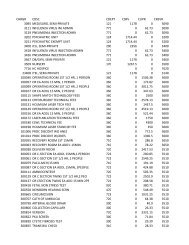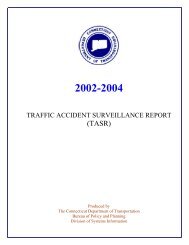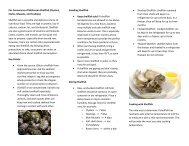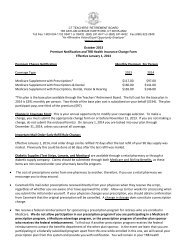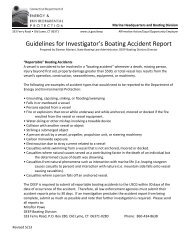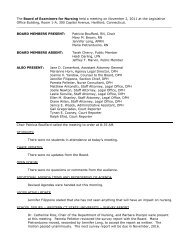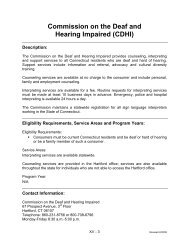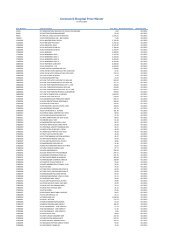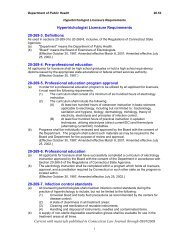Public Act 490 Guide - CT.gov
Public Act 490 Guide - CT.gov
Public Act 490 Guide - CT.gov
You also want an ePaper? Increase the reach of your titles
YUMPU automatically turns print PDFs into web optimized ePapers that Google loves.
PA<br />
<strong>490</strong><br />
SE<strong>CT</strong>ION 11: TERMINATION OF CLASSIFICATION OF PA <strong>490</strong> LAND AND NOTIFICATION REQUIREMENTS<br />
fallow for a period of time. In all cases, the land use has not<br />
changed and should remain classified under PA <strong>490</strong> and<br />
the assessor should examine the overall intent and purpose<br />
of PA <strong>490</strong> as it pertains to land classification. It is important<br />
for the farmer to communicate with the assessor when<br />
there is a change to the farming operation and to have a<br />
plan for continuation of the farming operation in order to<br />
maintain the land in PA <strong>490</strong><br />
Change or Sale of Acreage: If a landowner sells off<br />
some acreage of land that has been classified under PA <strong>490</strong><br />
farmland, the acreage not sold remains under classification<br />
and should not be declassified, provided the use has not<br />
changed. In the case of PA <strong>490</strong> forest land or open space,<br />
the landowner's remaining land should not be declassified<br />
unless the remaining acreage falls below the minimum<br />
acreage required for those classifications. The change in<br />
acreage should be noted in the PA <strong>490</strong> file for that property<br />
and the existing application amended to reflect the<br />
change in acreage. A new map or sketch clearly showing<br />
classified and non-classified land or change of ownership<br />
should be filed as well. A new Qualified Foresters Report<br />
may not be required unless the classification is over ten<br />
years old. In addition, the conveyance tax clock remains<br />
the same and does not start anew.<br />
Subdivision of PA <strong>490</strong> Land: There have been a<br />
number of legal challenges involving use valuation as<br />
impacted by the owner obtaining subdivision approval or<br />
a special permit for development after property is classified<br />
under PA <strong>490</strong>. The earliest Supreme Court case to touch on<br />
the issue is Marshall v. Town of Newington (1968). A farmer<br />
had sought a zone change and had his farm zoned industrial;<br />
he had already sold several parcels for industrial use.<br />
Then he sought to have the remainder of the parcels he<br />
owned classified as farmland under PA <strong>490</strong>. The Supreme<br />
Court declared that it was irrelevant that the adjoining<br />
property was sold for high prices as industrial land. The<br />
important focus was whether the land sought to be classified<br />
was being used for farming purposes. There was an<br />
analysis of the amount of farming being conducted.<br />
In a 1994 Superior Court case, however, Maynard v.<br />
Town of Sterling, the owner had his 36-acre farm approved<br />
for 18 building lots. At the time of trial, eight lots had<br />
houses built on them, and the remaining land was still<br />
being farmed with a corn crop. The lower court determined<br />
the development of eight out of 18 lots and offering the<br />
balance for immediate development was a change to the<br />
actual use of the whole farm, and the declassification was<br />
found proper. The court reasoned that the farmer's active<br />
development no longer served the public policy underlying<br />
PA <strong>490</strong>.<br />
In 2002, a similar fact situation was presented involving<br />
PA <strong>490</strong> forest land in Carmel Hollow v. Town of Bethlehem.<br />
A subdivision approval had been obtained and lots sold.<br />
However, the Connecticut Supreme Court found that the<br />
forest land could not be declassified by the assessor even<br />
though a number of lots had been sold because only the<br />
State Forester had the power to declassify forest land. The<br />
Court did not reach the issue of the impact of selling lots<br />
in this case.<br />
The Supreme Court in Griswold Airport v. Madison (2008)<br />
found that the mere approval of a special permit for 127<br />
condominium units on an area of an airport classified as<br />
open space did not justify declassification. The court found<br />
that the airport use had not actually changed.<br />
This line of cases makes it clear that the change of land<br />
use approvals by themselves do not require a declassification.<br />
But once a property owner begins to use those<br />
approvals by converting parts of the property into other<br />
uses, and offering it for sale for those purposes, especially<br />
in the case of farmland, he takes a risk that he will be<br />
viewed more as a developer and the remaining land will be<br />
declassified. At least there should be enough of a viable<br />
farming operation still active and not being offered for<br />
development that it is legitimately worthy of continued<br />
classification standing alone. Where there are minimum<br />
acreage requirements for open space, and definitely for<br />
forest land, declassification is proper if the minimum<br />
acreage is not maintained in that use.<br />
NOTIFICATION REQUIREMENTS FOR<br />
RECLASSIFICATION OF PA <strong>490</strong> LAND<br />
Reclassification occurs when PA <strong>490</strong> land changes from<br />
one classification to another, but stays within the same<br />
deeded ownership i.e. from PA <strong>490</strong> farmland to PA <strong>490</strong><br />
forest land. In many cases, the reason that the assessor is<br />
looking to have farmland reclassified is that the amount of<br />
forest land or woodland in the existing farm unit exceeds<br />
25 acres which is the minimum acreage needed for wood-<br />
26<br />
<strong>Public</strong> <strong>Act</strong> <strong>490</strong>: A Practical <strong>Guide</strong> and Overview • http://www.cfba.org/pa<strong>490</strong>guide.htm • Connecticut Farm Bureau Association




